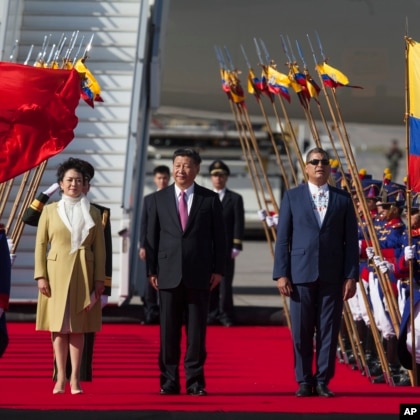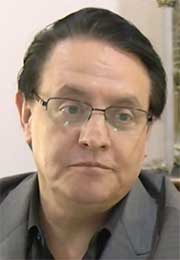Controversy in Ecuador’s Largest China-Built Infrastructure Project
Ecuador’s largest hydroelectric power plant, the controversial China-built Coca Codo Sinclair project, with financing from China, is facing internal and external challenges.
Transcript:
Édgar Zúñiga runs this 80-year-old ice cream shop in Quito. This shop has seen a lot of history, including back in the 1990s when power had to be rationed. There were blackouts and even a national decree to set the clocks forward an hour to take advantage of sunlight.
Édgar Zúñiga, Owner of Heladería Victoria: “Our freezers need to have the right temperature to be able to serve ice cream. So, when we were told, we were going to have two, three, four hours without electricity, for us it was a shock, but above all, a concern.”
The solution to the power problem in the country was this, a hydroelectric power plant built with help from China’s Sinohydro state-owned construction company. The Coca Codo Sinclair plant includes a transmission system that carries power across the country.
In 2016, then-President Rafael Correa and Chinese President Xi Jinping celebrated the plant’s inauguration in Quito.

China's President Xi Jinping, center, and his wife Peng Liyuan stand with Ecuador's President Rafael Correa, during a welcoming ceremony in Quito, Ecuador, on Nov. 17, 2016. (AP)
Rafael Correa, President of Ecuador: “We inaugurated the largest infrastructure ever built in this country, the hydroelectric plant Coca Codo Sinclair. That plant, with a power of 1500 MW, could provide electricity, alone, to all the homes of Ecuador.”
The project cost more than $2 billion and was financed with a $1.7 billion loan from the Export Import Bank of China.
Xi Jinping, President of China: “China is willing to work with the Ecuadorean side in light of the principles of cooperation like equality, mutual benefit, win win, flexibility, pragmatism, openness and inclusion to constantly deepen our cooperation.”
Since its completion, the plant has been surrounded by controversy. One critic is Fernando Villavicencio, an assemblyman who chairs the Oversight Commission.
 Fernando Villavicencio
Assemblyman
Fernando Villavicencio
Assemblyman
Fernando Villavicencio, Assemblyman: “China lent us the money and forced us to hire a company they wanted. The State could not decide which was the best company and the best cost. … It was a fatal negotiation, a loss of sovereignty, and of good sense.”
Villavicencio also questions the quality of the materials used and the appearance of thousands of cracks in the plant’s distributors, which conduct water to the turbines to generate electricity.
Fernando Villavicencio: “We discovered that for the year 2022, by July, which is the most recent data update we have, there are 17,499 cracks.”
Mechanical engineer Roberto Varhola worked as a consultant during the project’s construction and objected to the building of the power plant. He said there is not enough water flow to generate 1500 megawatts of power.
He also warned about the potential risks caused by the cracks in the distributors.
Roberto Varhola, Mechanical Engineer: “The number of cracks is a year’s long nightmare. … The worst nightmare a mechanical engineer has is for there to be a crack in a part.”
Varhola blames both the Ecuadorian authorities and the Chinese construction company for the structural problems.
Roberto Varhola: “As an Ecuadorian citizen I feel cheated and swindled because they should have done better.”
In response to media coverage of the problems with the plant, the Chinese state-run news outlet Global Times quoted Chinese Embassy officials in Ecuador saying, “the problem has been assessed by an international third-party independent testing agency … which concluded that it will not affect the operation and safety of the unit and that the plant is safe for its 50-year design life.” The report also noted the power plant generates more than 30 percent of the electricity in Ecuador.
In addition to structural problems within the plant, the Coca Codo project is also facing environmental threats from the outside.
In 2020, erosion caused a giant sinkhole, damaged oil pipelines in the region causing spills, destroyed part of a highway and carried away a part of the town of San Luis.
Erodita Andi has lived in the area for 15 years.
Erodita Andi, San Luis Resident: “When it rains, every now and then you hear the mountain as it comes down. That is the terror that we as a community live through every day.”
Geologist Carolina Bernal links the aggressive nature of the erosion to the way sediments are managed by the power plant. She and other experts say prior environmental studies should have been better analyzed before construction started.
Carolina Bernal, Geologist: “It’s an area that is having more and more problems, because there is a threat that due to the constant accumulation of sediments, the mechanical room will flood and we would have to be dredging all the time, removing that sediment.”
Engineer Jorge Sevilla says there was a lack of updated geological studies prior to construction. He says increased sediment upstream of the dam is raising water levels and could create clogging which would jeopardize the operation of the plant.
Jorge Sevilla, Geological Engineer: “It was thought that what was already done was enough and it was not.”
Plagued with concerns surrounding the plant, residents in area towns have their own complaints of unmet economic expectations.
Luis Herrera, Local Resident: “The hydroelectric project was going to generate tourism, attract more people to see the hydroelectric installations, but it didn’t happen at all.”
Instead of money flowing into the area, repairs of the plant will cost money, as will dealing with the erosion. Ecuador and the U.S. are working together to mitigate the environmental threats to the plant in order to keep the lights and freezers on in the country.
“When it rains, every now and then you hear the mountain as it comes down. That is the terror that we as a community live through every day.”
Erodita Andi, San Luis Resident